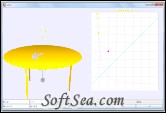|
Orbiting Mass on a Table 3D Model 
|
Frictionless dynamics simulation. The Ejs Orbiting Mass on a Table 3D model displays the frictionless dynamics of two masses that are attached via a string through a hole in a horizontal table. Mass m moves on the table in two dimensions while mass M hangs vertically and just moves up and down. The simulation allows displaying the motion of the masses as well as the effective potential energy. The ratio of the masses, the total energy of the system, and the initial radial position of the mass on the table can be changed via textboxes. A description of the system and example student activities are provided. You can modify this simulation if you have Ejs installed by right-clicking within the plot and selecting "Open Ejs Model" from the pop-up menu item.
Two masses are attached to the ends of a string going through a hole in a table. Mass m moves on the table and while mass M hangs vertically. Friction is negligible. It is further assumed that M moves along the vertical and that neither mass goes through the hole (because the string is long enough and the initial velocity of mass m is not purely radial). The simulation allows displaying the true motion of the masses, as well of that of the equivalent one-dimensional problem.
1. The unit mass is the mass m of the particle on the table.
2. The unit length is uL = (L2/m2g)1/3, where L is the angular momentum of particle m around the hole.
3. The unit time is uT = (L/mg2)1/3.
4. In these units we have m = L = g = 1 and the total mass is 1+M/m.
5. Gravitational energy is 0 when m is in the hole.
6. On the right the effective potential energy Mr/m+1/2r2 is displayed in red. You may use the mouse (or the controls below) to select the mechanical energy E and the initial polar distance r.
7. The point of view of the three-dimensional projection can be changed with the mouse.
8. Each whole image can be moved with the mouse while pressing Ctrl.
9. To change the zoom in the projections, press Shift when moving up or down the mouse pointer.
10. Put the mouse pointer over an element to get the corresponding tooltip.
Requirements:
* Java
The license of this software is Freeware, you can free download and free use this graphing software.
